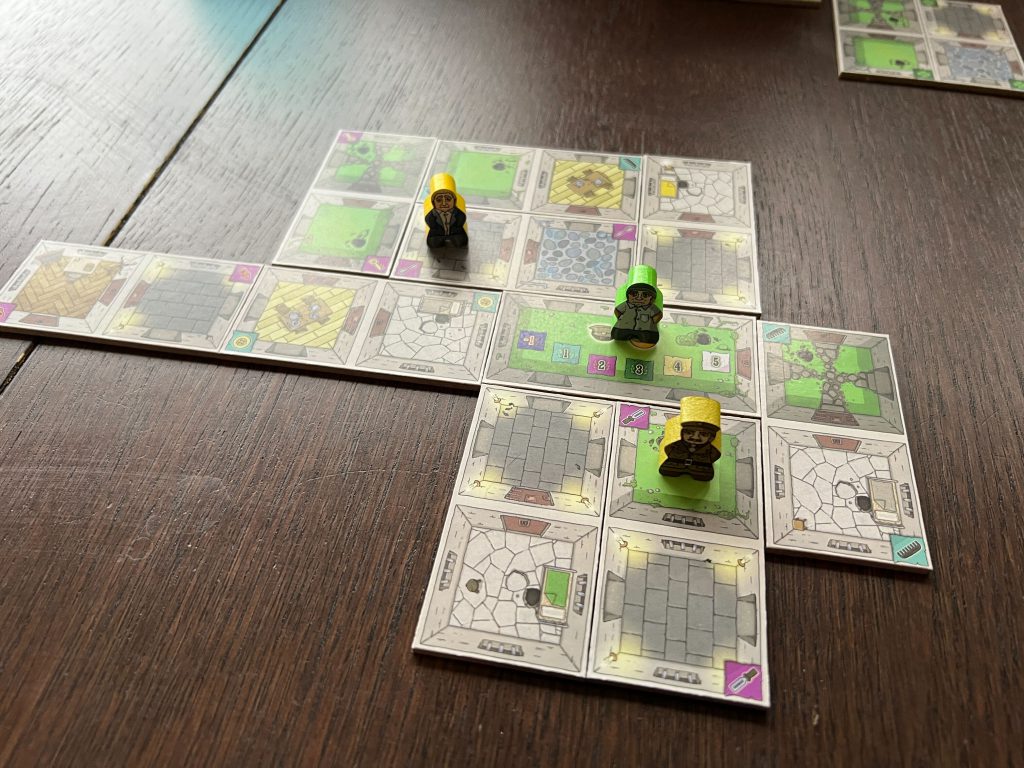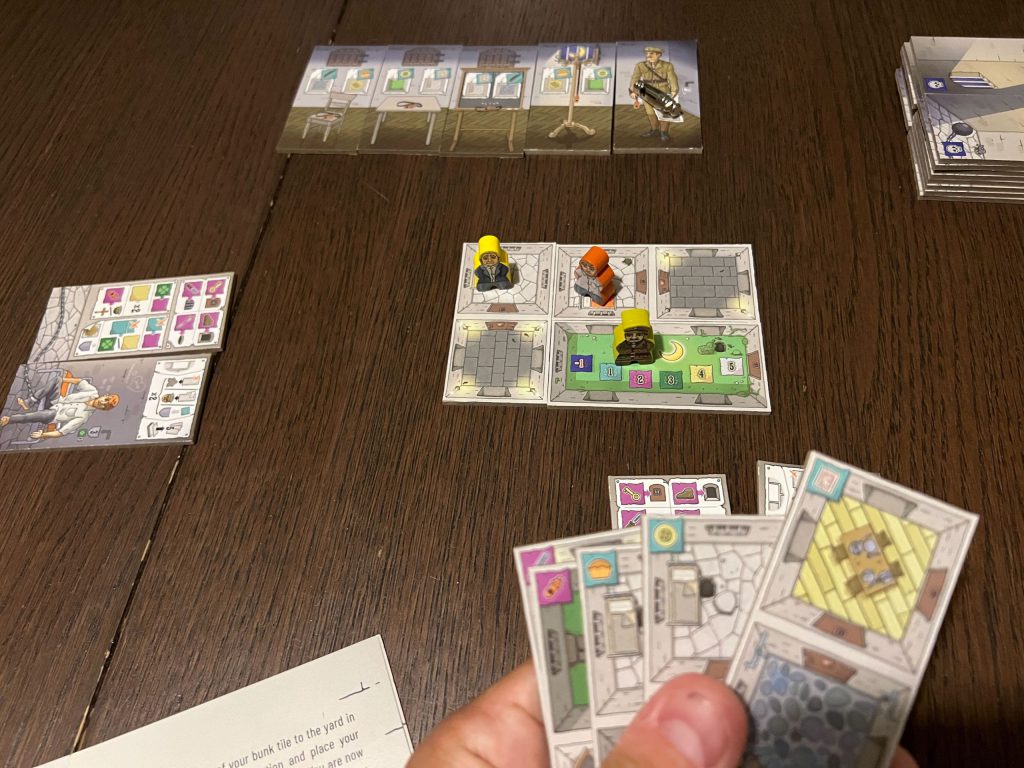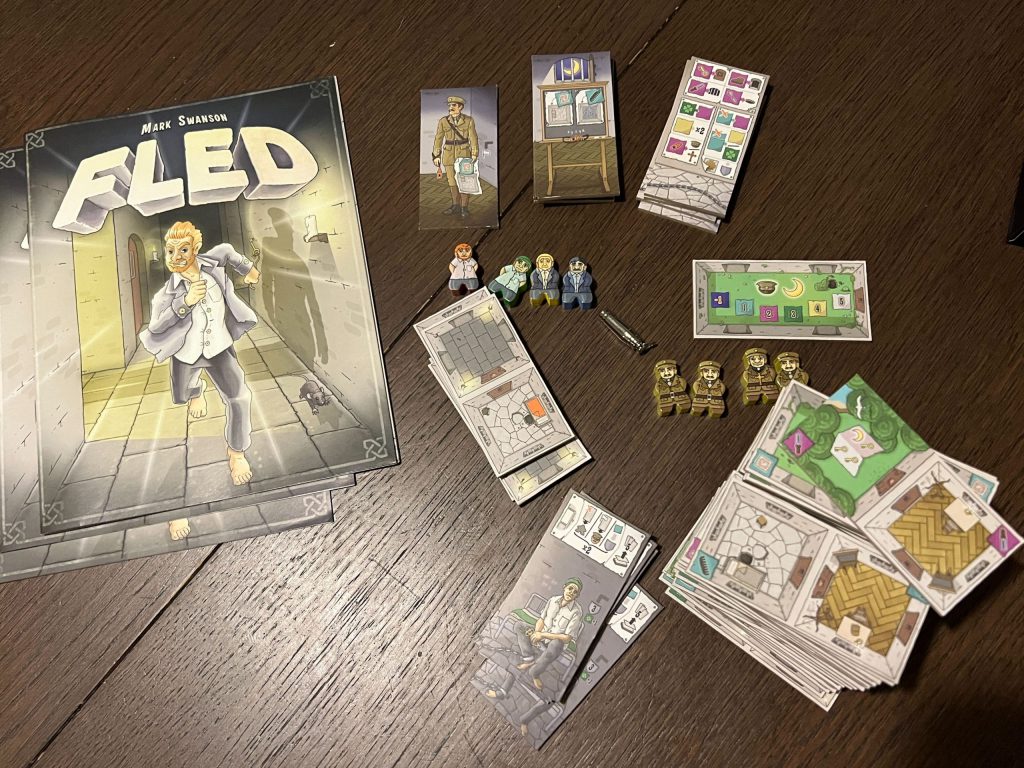Fled challenges up to four players to escape from a Victorian prison
From Mark Swanson, the creative mind behind the fantastic Feudum (which we rated incredibly positively when we got our hands on it back in 2018) comes Fled, a game all about gathering resources as well as taking big risks as you explore, and ultimately attempt to escape from a labyrinthine Victorian prison.
Fled challenges 2-4 players to explore an interweaving prison on Spike Island, you’ll be laying out the prison itself as you take turns placing tiles from your hand. You’ll also need to keep an eye on the roll call tracker to make sure you can start collecting contraband and trading them up for tools so that you can move around the prison and, ultimately, escape into the surrounding woodlands.
Set-up is incredibly simple, with a row of roll call cards — which features the governor to the right and four reversible cards to its left (day on one side, night on the other). Each have iconography that denotes cards that can be interacted with by the players and how. A whistle token is placed on this, which can be moved by players on their turn. Opposite that, you’ll create a deck for the draw pile of tiles. Each player gets a character card which shows the turn structure and a reference card — which shows how tools can be used, and how things can be traded up on certain tiles. Finally, you’ll start creating Fled‘s board in the centre of the playing area. A central yard is placed and each player places their bunk room, ensuring their attached corridor is touching the yard in some capacity.

It’s approachable and surprisingly easy to set up once you’ve familiarised yourself with the rules. In fact, the real complexity of Fled comes during play rather than its sweeping mechanics. What I mean by that is that it’s the player placement of the prison tiles and movement of the warders that add complexity to the game, rather than the design of it.
Before I explain the turn structure, I’ll explain the contraband and tool system, and I’ll do that by talking about the tiles first. Each tile has entryways on them; they can be tunnels, doors, windows or archways. These have to connect and make sense when they do so; For instance, you’ll mostly connect doors to doors and windows to windows — archways are the outliers as they can connect to themselves and the other two options. It feels a little bit like dominos, but perhaps more like somebody took a set of dominos and continued iterating and iterating on it until it became about creating clusters rather than links. You’ll need to discard tool tiles from your hand to move through appropriate objects (file through window, shoe through archways) or to use them from your inventory, but you won’t be playing with your inventory for a few turns unless you’re fortunate.
Each player gets the chance to place one tile on their turn, and because each player is, ultimately, aiming to nab the 5VP from being the first to escape the map, they’ll likely be building off in their own directions until important rooms like the warder’s room appear (where contraband becomes tools) or the boundaries of the prison are reached (it’s capped at 12×14, by my maths). As more tiles are revealed more warders are added into the game as their tiles are revealed — clever placement can distribute them in the way of your rivals, but because prison construction alternates with each turn you’ll likely have that favour returned.

Of course, snaking off your own wing of the prison is all well and good as long as you can keep the tiles in your hand to actually explore them. That’s not as easy as it sounds; Which means you need to start using whistles, warders and your inventory to change the tools that you have at your disposal.
So, then, the player turns. On your turn, you have a whole stack of actions that you can take, but it’s a refreshingly quick process as long as you know what you want to do ahead of time. For a start, you’ll place a tile to expand the prison. Secondly, you’ll perform any two actions from a choice of three: 1) Discard a tool to move your character, or discard a whistle to move a warder (and the whistle tile). 2) Surrender a card to the governor’s tile pile. 3) Commit a tile to your inventory — if it’s contraband it’s free but you have to be on a tile corresponding to the whistle’s location, if it’s a tool then you have to be in the warder’s quarters, share a space with the chaplain and must trade out contraband from your inventory. After this, you replenish your hand, taking one card from the governor’s pile if you wish, but the rest from the draw pile.
A turn, as such, can be rapid, especially if players are just adding contraband to their hands as they’ve struck lucky with the room they’re in, or just moved the whistle along to benefit them. The inventory does have a cap, that said, but you can store limitless shamrocks in there (as long as it doesn’t already have three items in there when you try).

While warders — prison guards — are the obvious villains in this situation, it’s the players that move them around. Using a whistle allows a player to move a guard 0-3 spaces and, if they end their move on the tile with a player then that player is shackled (a random tile from their hand is flipped into a shackle), or, if they’re already shackled, they’re sent to solitary and miss a turn or are returned to their bunk. You can, technically, have the chaplain free you from your shackles, however, the odds of that happening are quite low, especially as the chaplain serves as a portable contraband converter for most players. The wrinkle in moving around guards for your turn is, of course, that as you move them you move the whistle along the roll-call tracker, which opens you up to being caught by warders and changing the contraband that can be converted by players.
Ultimately, you’ll want to add high-value items to your inventory (not just because they need to be there for you to escape, but because they score high if somebody else beats you out of prison), keep the warders away from you, and try and direct the construction of the prison map so that you have a great variety of different tile types between you and the prison exterior. The latter is especially important because if it’s daytime (for each moon tile revealed, more whistlestops become night) then the requirement to breach the treeline and exit the prison are much harder. Similarly, if you can get the chaplain card to fall in your path then that’s great, if not in the least because other players will compete over moving them in their direction.
Over the years I’ve played a lot of games that have felt like heist movies, and a lot of games that have felt like you’re making and executing an elaborate plan, however, I think that Fled is probably the closest to the feeling of an escalation required to pull off a prison break. The fact that getting caught by warders results in your hand being stripped of something you might have been stashing aside for later turns is an massive threat, and somebody moving a warder toward you, or placing a tile that brings on into play near you, feels like deeply personal sabotage.
Experienced players will likely be able to get a two-player run of this down to 25 minutes, possibly even faster if they decide that they don’t want to sabotage each other and instead focus on a race to escape the prison grounds — however most players, especially larger groups or people playing for the first few times, will find Fled taking much longer.
The Fled Kickstarter is due to go live in March ’24.
Comments are closed.